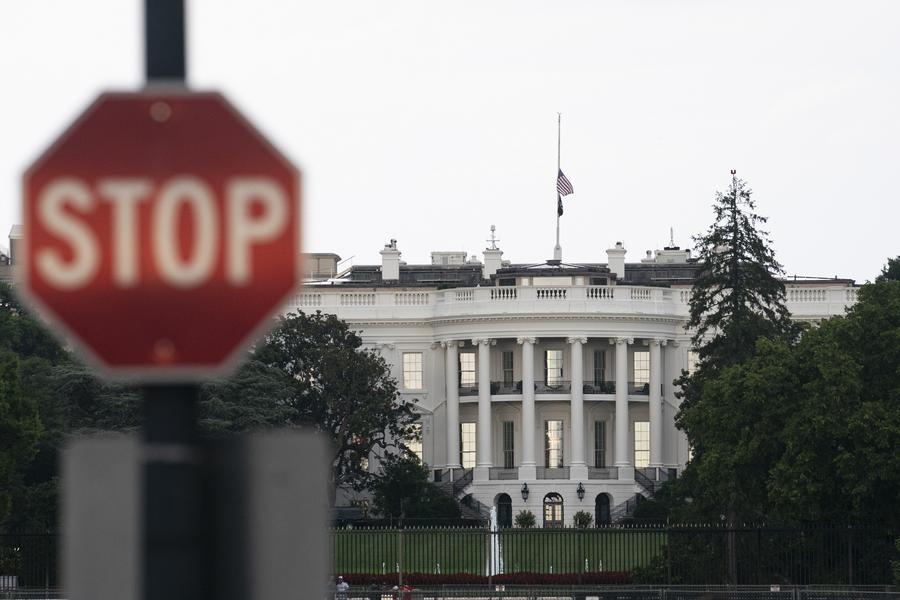
This photo taken on Aug. 4, 2022 shows the White House and a stop sign in Washington, D.C., the United States. (Xinhua/Liu Jie)
The United States may not witness a resurgence in job opportunities, while consumers continue to contend with inflated prices due to higher production costs outside China.
by Wang Honglin
This week U.S. President Joe Biden, who attributed the loss of American jobs to "Made in China," imposed significant tariffs on more Chinese goods with high competitiveness. However, will higher tariffs on Chinese goods rejuvenate the lost American manufacturing sector? The answer, to simply put it, is no for several reasons.
Firstly, while higher tariffs may restrict the imports of Chinese goods into the American market, they also lead to elevated prices for consumers, who have to buy products with inferior quality. This not only burdens millions of American consumers, but also undermines their overall welfare.
Secondly, the abuse of high tariffs may incent Chinese firms to relocate their production facilities to other countries such as Mexico and Vietnam. The United States may not witness a resurgence in job opportunities, while consumers continue to contend with inflated prices due to higher production costs outside China.
Thirdly, high tariffs can adversely affect American manufacturing firms by diminishing their incentive to streamline production costs and enhance product quality. As a result, domestically produced goods may struggle to compete in international markets, ultimately jeopardizing the longevity of these businesses in a fiercely competitive landscape.
This aerial panoramic drone photo taken on July 11, 2023 shows new energy vehicles for export at a terminal of Taicang Port, east China's Jiangsu Province. (Photo by Ji Haixin/Xinhua)
Take the electric vehicle (EV) industry for instance. While American EV companies may experience temporary success in the domestic market, they risk eventual obsolescence due to their inability to match the competitiveness of their Chinese counterparts on a global scale.
So, what's the viable solution to reinvigorating manufacturing jobs in America? The answer lies in addressing the formidable obstacle that undermines the competitiveness of the American manufacturing industry: the U.S. dollar.
Since the 1970s, the U.S. dollar has been the world's primary reserve currency, shielding it from necessary depreciation despite enduring persistent twin deficits -- trade and fiscal. Economic theory dictates that a currency must depreciate under such circumstances, yet the dollar has defied this principle due to its privileged status.
This status enables the American government and Wall Street to borrow at advantageous rates and invest abroad, while consumers benefit from cheaper imports and travel expenses overseas. Nevertheless, the status of the currency proves detrimental to the domestic manufacturing industry, as it discourages depreciation necessary for competitiveness by attracting excessive international investment.

A Wall Street sign is seen in front of the New York Stock Exchange (NYSE) in New York, the United States, on March 13, 2023. U.S. stocks ended mixed on Monday. (Photo by Michael Nagle/Xinhua)
Consequently, the path to revitalizing American manufacturing jobs entails relinquishing the hegemony of the U.S. currency gradually. By encouraging the adoption of alternative reserve currencies such as the Euro, Japanese Yen, or the Chinese Renminbi (RMB), the illusion on the U.S. dollar would fade.
This shift would foster competitiveness in the American manufacturing sector and pave the way for the resurgence of its domestic employment opportunities.
Such a reform may entail short-term hardships, including potential depreciation of the U.S. dollar that could strain government finances and consumer purchasing power. Nevertheless, in the long term, this re-calibration represents the most viable strategy for reviving American manufacturing jobs and ensuring sustainable economic prosperity.
Editor's note: Wang Honglin is a research fellow of China Academy of Financial Research, Shanghai JiaoTong University.
The views expressed in this article are those of the author and do not necessarily reflect those of Xinhua News Agency.■
